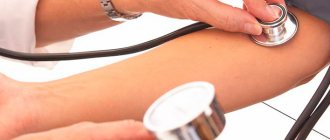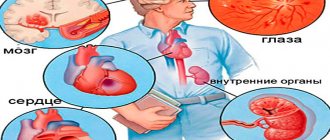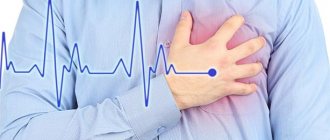It is a proven fact that arterial hypertension is one of the most common diseases of the modern world.
In the 21st century, you can sit at a computer and earn millions; there is no need to go to supermarkets or attend lectures at a university.
Thus, modern man moves little and eats heavily. If we add to this the low quality of products, poor ecology and stress, then we get a favorable background for the development of pathology of the cardiovascular system.
It may happen that in connection with a long-awaited vacation or business trip, there is a need to use the services of airlines. There is a lot of information in the medical literature about whether you can fly on an airplane if you have hypertension. All of it is heterogeneous and sometimes raises doubts.
This article will briefly discuss the basics of the influence of high altitude on the human body, describe contraindications for flying, as well as recommendations that will make the trip as comfortable and safe as possible.
- 1 What are the dangers of flying if you have hypertension?
- 2 What is the pressure on the plane?
- 3 Cardiac risk
- 4 Effect on blood vessels
- 5 How to prepare for a plane flight if you have hypertension?
- 6 Contraindications for flying
- 7 Videos on the topic
What are the dangers of flying if you have hypertension?
The generally accepted view among medical professionals is that flying on an airplane will not cause adverse effects if hypertension is completely controlled.
Air transport is safe for most patients with cardiovascular pathology.
People who travel with high blood pressure or severe heart failure are a different matter. Primarily, excluding the physical factors associated with climbing and acceleration, many people experience fear or anxiety.
A large amount of stress hormones (adrenaline, norepinephrine, vasopressin) are released into the bloodstream, which cause spasm of peripheral vessels and an increase in cardiac output. Due to a decrease in atmospheric pressure, a compensatory increase in blood flow in the pulmonary circle occurs, which increases the risk of developing pulmonary edema, especially in people suffering from heart failure.
Uncontrolled arterial hypertension causes damage to the vascular wall and contributes to the formation of blood clots of various locations.
When flying long distances, a person is forced to sit for a long time, as a result of which the venous outflow from the lower extremities is disrupted.
Thus, the formation of blood clots with their further migration is possible. If we add to all of the above individual autonomic reactions that prevent sufficient fluid intake and contribute to dehydration (nausea, vomiting), then we get a favorable background for the development of a vascular accident.
Signs of interior depressurization
In 2007, Airbus released a note on cabin decompression consciousness, which stated that at 12,000 metres, people have only 18 seconds to act meaningfully if oxygen starvation sets in. The risk of hypoxia is greater because passengers may not realize they are suffering until they can no longer breathe and lose consciousness.
Signs of sudden decompression include a loud bang or pop as the pressure inside and outside the plane stabilizes. Symptoms of hypoxia may appear - nausea, headaches and euphoria. When they occur, you need to put on an oxygen mask.
What is the pressure on the plane?
Modern aircraft are characterized by increased comfort; designers are trying to create conditions that are as close as possible to standard ones.
Even in pressurized airliners, a person experiences extreme stress.
During a standard flight at an altitude of 10 to 14 thousand meters, the pressure in the aircraft cabin is equal to that if you were in an open cockpit or on the top of a mountain at an altitude of 2000 to 2500 meters.
Using basic calculations, at a temperature of 22 degrees Celsius you experience a pressure of 570 mmHg, which is 190 mmHg less than at sea level. It is important to take into account the rapid change in gradient during takeoff and landing. Few people know that with a normal oxygen concentration in the cabin (21%), very low air humidity is maintained (from 10% to 20%).
An ordinary flight, which is well tolerated by young healthy people, can be a test for the blood vessels of a hypertensive patient.
The need for supercharging [edit | edit code ]
A safe altitude (based on air pressure) is less than 4 km. Any ascent to a height of more than 4 km requires the use of various life support systems.
With an ascent to a height of more than 3 km, a person begins to show signs of oxygen starvation (you want to sleep). At altitudes above 9 km, gas bubbles may be released from body fluids (aeroembolism). At altitudes above 19 km, boiling of subcutaneous fluid is observed. The air temperature at an altitude of more than 11 km can reach −60 °C. To fly an aircraft in such unfavorable conditions for life, it was necessary to create on-board life support systems.
Cardiac risk
The heart experiences increased stress during flight due to changes in vascular tone, increased pulmonary vascular resistance and myocardial ischemia.
Stress factors such as noise, vibration and fear increase the concentration of catecholamines, which causes tachycardia.
An increase in heart rate can trigger abnormal circulation of electrical impulses in the heart muscle, thereby triggering arrhythmia. Due to the short diastole, the myocardium experiences oxygen deficiency, which may result in the development of an attack of ischemia and even a heart attack.
If a person suffers from chronic left ventricular failure, spasm of the pulmonary vessels can lead to pulmonary edema.
Effect on blood vessels
At high altitudes, atmospheric pressure and oxygen concentration in the environment decrease. The body tries to compensate for these fluctuations by spasming peripheral blood vessels and redirecting blood to vital organs. Thus, blood pressure and heart rate increase.
Thrombus in a vessel
Reduced blood flow in the lower extremities and pelvic organs promotes the formation of blood clots, which can migrate and cause blockage of the pulmonary artery.
This most serious and potentially fatal condition can be prevented by drinking enough fluids and taking short walks around the cabin every 2 hours.
How do blood vessels behave at high altitude?
Due to changes in atmospheric pressure, the human circulatory system is subjected to severe stress. Lack of oxygen causes the heart rate to increase. The blood vessels narrow. Their walls are subject to strong blood pressure. As a result, the vessels lose their elasticity.
For a healthy person, infrequent flights are not dangerous. The body is able to quickly normalize its condition and recover after a flight. The blood vessels of a hypertensive patient are constantly exposed to blood pressure; a flight can greatly aggravate their condition.
As a result of a long stay in one position, often after landing there is a feeling of fullness in the legs, cramps appear, and the limbs swell. Inactivity provokes the formation of stagnation in the legs, and blood flow in the vessels slows down. This condition increases the risk of developing venous thrombosis. Problems also arise in the presence of varicose veins - venous insufficiency and thrombophlebitis.
The most dangerous consequence of flying for blood vessels is deep vein thrombosis. This condition causes blockage of blood vessels in the pulmonary artery and is fatal.
How to prepare for a plane flight if you have hypertension?
If you are planning to travel by plane, you must fulfill a number of prerequisites that will help prevent complications:
- proper nutrition
. Avoid salty foods. It is ideal to prepare a suitable dish at home and take it with you. It can be lean meat or fish, vegetables or fruits. You can ask the guide for a low-salt lunch or snack. Drink enough fluids (water, juices); - medicines
. Strictly follow the medications prescribed by your doctor, do not forget to take them with you on your trip, including emergency medications for hypertensive crisis and angina pectoris (Farmadipine, Nitroglycerin); - visit your healthcare provider
. Listen to the recommendations regarding the flight, perhaps the doctor will prescribe laboratory and instrumental tests (ECG, general blood and urine tests, lipid profile); - sleep and rest
. On the eve of the flight, do not do heavy physical work, avoid overeating, drinking alcohol, sleep at least 8 hours; - tonometer
_ Take with you on your trip a working blood pressure measuring device and spare batteries (if it is electronic).
If you feel unwell during the flight, seek assistance from the accompanying staff. During the flight, get up and walk around the cabin for 10 minutes every 2 hours, this way you prevent excessive blood stasis in the legs and the formation of blood clots.
Avoid stress; if you feel fear, it is acceptable to use sedatives. Do not focus on your arterial hypertension, do not think that it can become an obstacle to travel. Prepare thoroughly, but don't overdo it.
What to do if a crisis occurs
Every plane has a first aid kit!
For hypertensive patients, oxygen inhalations are a must! Before your flight, do not forget to check whether there are special oxygen bags on board. If the airline doesn't have them, order one for yourself in advance.
In any case, a patient with high blood pressure should take with him on the flight a first aid kit with the necessary medications (capaten, validol, corvalol, valerian).
In the worst case scenario, the plane may land at the nearest airport, where assistance will be provided by qualified doctors.
Contraindications for flying
There is a fairly wide range of contraindications for traveling by air.
For informational purposes, below are presented not only cases that relate to arterial hypertension and cardiac pathology:
- severe respiratory failure with shortness of breath at rest;
- unstable angina;
- pneumothorax or pneumomediastinum;
- gastrointestinal bleeding;
- severe anemia - hemoglobin less than 75 g/l;
- uncontrolled arrhythmia and cardiac conduction disturbances (atrioventricular block, stage 3);
- severe congestive heart failure;
- period after myocardial infarction - most experts agree that the period of 21 days after illness is an absolute contraindication to flying;
- deep vein thrombosis of the lower extremities until adequate preventive measures are taken (anticoagulant therapy or surgical treatment);
- pregnancy period is more than 36 weeks, also during the entire third trimester, if there is a history of premature birth or miscarriage;
- within 10 days after surgery on the abdominal organs (appendicitis, cholecystitis) and 3-4 weeks during thoracic surgery (lungs, coronary vessels, heart).
Any indication can be absolute or relative in a given situation. Always consult your doctor before traveling and inform him of the type of transport you plan to use.
What happens during the flight
Long-haul flights disrupt circadian rhythms
Simply put, circadian rhythms are daily biological rhythms
, and they occur every 24 hours. During long, long-distance flights, these rhythms can become disrupted. The release of hormones, feelings of hunger, drowsiness and anxiety, like many other functions in the body, depend on our so-called internal clock.
The disruptions are most pronounced when you travel long distances and with a sudden change in time zones.
In these cases, the body needs some time to recover and return to normal. The main problem with a sudden change in time zones is that the body needs one day
rest for every hour difference.
That is, if the difference in zones is 6 hours, it will take you about 6 days to fully recover.
What to do if your trip takes less than a week?
If you are on a short trip for work, you should not immediately try to adapt to the new time zone, because, from a physiological point of view, this is impossible.
fresh air and, especially, sunlight will help you restore your routine
Due to the fact that the human body adapts more easily to long daylight hours than to short ones, flights from east to west are always smoother than from west to east.
Video on the topic
About the effect of high and low atmospheric pressure on hypertensive patients in the video:
The safest type of transport will be a comfortable and reliable companion for a hypertensive patient only with the right approach. Following the recommendations when preparing for a flight, a preliminary medical examination and careful monitoring of blood pressure will make your trip absolutely harmless.
The information on the website is for reference and general information, collected from publicly available sources and cannot serve as a basis for making a decision on the use of medications in the course of treatment.
website
And we also have
It is physically difficult for people with hypertension and acute heart disease to fly by plane, although it is considered one of the most comfortable and fastest means of transport for long trips. Shaking and turbulence at high pressure cause dizziness, noise in the head, weakness, nausea, and sometimes vomiting. Before buying a plane ticket, hypertensive patients should take into account all the risks so that the long-awaited trip does not turn into torture.
Does your blood pressure go up or down on an airplane?
An intense negative effect on the human circulatory and cardiovascular system occurs at the beginning and end of the flight during sudden changes in atmospheric pressure - a rapid decrease during takeoff and an increase during landing. Despite the regulation and maintenance of constant temperature, humidity and air circulation in the cabins of modern aircraft, even healthy passengers experience unpleasant sensations.
Enter your pressure
Move the sliders
When an airplane gains altitude, passengers' blood pressure rises. This is due to the difference between the external air pressure and the pressure in the tympanic cavity of the ear.
Constriction of blood vessels rapidly increases blood pressure.
In pressurized aircraft cabins, reduced pressure, which is 75% of normal atmospheric pressure, leads to a decrease in the level of oxygen in the blood, and in severe cases, to hypoxia or, in other words, to oxygen starvation. First of all, the brain and myocardium react to a decrease in oxygen concentration in the air. Hemodynamics in the legs gradually worsen, blood viscosity increases, the lumen of blood vessels narrows, which often provokes increased pressure, shortness of breath, rapid heartbeat, dizziness, fainting, abnormal heart rhythm, and increases the risk of heart attack or stroke. An oxygen bag or inhaler, which is equipped on the planes of some airlines, helps against such conditions.
Medicines used during the flight
Before air travel, a person with hypertension should consult a specialist. If the doctor’s answer is positive about the trip, medications that quickly lower blood pressure are prescribed. Their list includes:
- Diuretics – relieve blood pressure due to their diuretic effect. The drug begins to act within 1 hour. Prohibited for patients with kidney disease.
- Beta blockers lower vascular tone and reduce the strength and number of heart contractions. The pressure decreases within 30 minutes.
- Inhibitors block enzymes that cause persistent increases in blood pressure. The action occurs within 15-60 minutes. Inhibitors have a more gentle effect on the kidneys.
In addition to medications that lower blood pressure, the first aid kit must include medications that relieve headaches and heart pain, sedatives, and ammonia.
Can someone with hypertension fly?
To minimize risks, you need to take into account in advance the possible deterioration of your health on board the aircraft. The danger of flying depends on the degree and stage of hypertension. If you feel normal and have a stable course of the disease, you can fly, but it is important to strictly follow the recommendations of your doctor. Flights are contraindicated for hypertensive patients who suffer from other diseases, namely:
- aortic aneurysm;
- pericarditis;
- ischemic disease;
- congenital heart defects;
- angina pectoris;
- respiratory tract diseases;
- leukocytosis;
- anemia.
Increased stress on the heart causes pain.
The younger and healthier a person is, the easier the blood vessels cope with overloads at altitude; accordingly, the longer a person suffers from hypertension, the worse the blood vessels react to physical activity. The elasticity of blood vessels can also be affected by high cholesterol levels, which reduce the ability of blood vessels and heart muscle to quickly respond to changes in pressure associated with acceleration, takeoff and landing. In such situations, hypertensive crises, heart rhythm disturbances, and pain in the heart area occur.
Use of medications
Turbulence and low oxygen levels increase stress on the heart, causing it to work harder. This leads to a sharp increase in blood pressure, which can trigger a heart attack and even stroke. Therefore, it is advisable for people with high blood pressure to take antihypertensive medications before flying.
There is a first aid kit on board the plane, but it is better to take with you medications prescribed by a doctor that will help stabilize your condition and quickly bring yourself back to normal. Medications should always be on hand, so you need to take them in your hand luggage on the plane.
If you feel unwell and have a headache, it is advisable to try to relax, try to fall asleep or at least take a nap. This will make the flight faster and easier.
Imagine that you are comfortably seated in an airplane seat and enjoying the flight, dreaming of an upcoming vacation on the seashore or a meeting with loved ones. And in order to make you comfortable and comfortable, just like on the ground, airliners have special systems that are responsible for the quality of air in the cabin.
Passenger planes fly at an altitude of 9 to 12 thousand meters. It all depends on the model, since each of them has its own “ideal” altitude, at which the airliner consumes the minimum amount of fuel and experiences little resistance. After the plane has taken off and gained altitude, it finds itself in atmospheric air, the parameters of which are very different from those at the surface. The air that is in the cabin is enough for about 15-20 minutes of flight, and then the oxygen content in it drops and it becomes impossible to breathe. But in order to add fresh air to the cabin, you can’t just open the hatch for ventilation. The fact is that the oxygen content at such a height decreases to 7-8%, while at the bottom this figure is 21%. And the atmospheric pressure outside (the second no less important indicator of air) decreases to 170-250 mm. rt. Art., instead of the usual 740-760 mm. rt. Art.
But with increasing altitude, even with a constant percentage of air components, the partial pressure of oxygen drops, which leads to a general decrease in the level of oxygen in the blood of a person, or any other living creature. Therefore, it is not enough to simply enrich the atmospheric air with oxygen; it is necessary to normalize the pressure.
To ensure comfortable conditions, all airliners have a special air conditioning system. The system takes in air that is overboard and compresses it using compressors. Due to this, the oxygen density in it increases to acceptable values. At the same time, the temperature parameters are equalized to a comfortable level.
In terms of pressure, the cabin of an airliner is maintained at a lower pressure than what is required at the airport. As a rule, this is 600-650 mm. rt. Art., which corresponds to an altitude of 1300-1800 meters above sea level. It is believed that this is the lower limit of atmospheric air pressure that is comfortable for humans.
But the air conditioning system has one significant drawback: the air entering the cabin is too dry. Rarefied in the atmosphere, it contains less moisture, and when delivered to the cabin it is additionally dried. This is done to prevent ice from freezing in the air conditioning system pipes, which can lead to blockage. Therefore, some passengers experience constant thirst during the flight and also complain of dry eyes and throat.
Traveling by air is not only convenient, but with their help you can quickly get to distant countries. However, for some categories of people, moving with their help can be life-threatening. This primarily applies to patients with hypertensive blood pressure and other heart ailments.
Can hypertensive patients fly on an airplane? This topic is relevant for many patients with this disease. What needs to be done to ensure that a flight for a person with hypertension does not bring complications and negative consequences?
The busyness of modern people forces them to quickly move over long distances; air transport is ideal for this purpose. However, flying is not inherent in the nature of the human body, and therefore often causes stress in a person.
People with certain pathologies, in particular the digestive and cardiovascular systems, are at risk. The fact is that the higher the aircraft rises above sea level, the more strikingly the atmospheric pressure and the composition of the microclimate and air change. As a result of such dramatic changes, the body begins to produce a stress hormone, the so-called adrenaline, which provokes:
- Increased heart rate.
- Increased blood pressure.
- Acceleration of metabolic processes.
In addition, during the flight, all passengers, without exception, experience a general condition - stuffy ears, which lasts from two minutes to twelve hours. Why does this phenomenon occur? Experts explain its appearance by a significant difference between the pressure in the airplane cabin and in the human middle ear. When the board is at an altitude of more than 2 thousand meters above sea level, the air pressure inside and outside the eardrum rises to the maximum level, which provokes this syndrome, which is medically defined as blocked ears.
Based on the above, we can say that if a person has some inconsistencies in health, especially in the cardiovascular system, it is advisable to choose a more optimal mode of transport, for example, a train, a car.
Is it possible to fly on an airplane with high blood pressure? There is no clear answer to this question, and the success of the flight depends on the degree of illness, blood pressure levels, and the general well-being of the hypertensive patient. You should approach this issue especially carefully if the patient has reached old age.
At an advanced stage of the disease, after suffering a hypertensive crisis and stroke or surgery, doctors are categorically against flying. It follows from this that flying on an airplane with hypertension is allowed only if you feel well and with the permission of a doctor.
In addition to high blood pressure, hypertension is characterized by the following clinical picture:
- Headache in the occipital and temporal areas of the head.
- Pain and burning in the region of the heart.
- Unpleasant discomfort.
- and numbness in the limbs.
- Nausea accompanied by vomiting.
- Dizziness.
- Increased fear.
- Panic and excitement.
- Facial redness, swelling.
- Excessive sweating.
The above-described symptoms during an airplane trip can manifest themselves with double intensity, which can provoke serious complications:
- Hypertensive crisis.
- Heart attack.
- Death.
The high probability of developing such a clinical situation is explained by a sharp drop in atmospheric pressure at the time of takeoff and landing of the airliner. When he gains altitude, the volume of oxygen present on board begins to rapidly fall, which provokes a rapid deterioration in the health of the hypertensive patient. As soon as the plane begins to move along the runway, certain painful processes are observed in the human body that negatively affect well-being.
What happens to a person's blood pressure on an airplane? Even people with quite good health have a hard time with pressure surges during a flight; they experience:
- Headache.
- Nausea.
- Vomit.
- Congestion in the ears.
Possible cardiac risk
When the plane reaches an altitude of 3 thousand meters, the amount of oxygen decreases significantly; during long intercontinental flights, airliners rise to a height of 10 thousand meters and higher. For hypertensive patients, this is a very serious situation, since the oxygen level can drop to a critical level.
Danger also awaits those patients who have a history of:
- Atherosclerosis.
- Angina pectoris.
- Ischemia.
- Heart attack.
- Stroke.
So-called oxygen pillows help to cope with low oxygen levels - they provide additional ventilation to the lungs during critical moments of the flight. However, many airlines have abandoned these devices due to the high explosiveness of oxygen.
Effect of flight on blood vessels
During an air flight, the vessels of the circulatory system also feel excessive stress, because a person is forced to remain in a sitting position for a long time, but the veins in the legs suffer the most. Due to low hemodynamics, a narrowing of the vascular lumens is observed, which in turn provokes an increase in blood pressure. For hypertensive patients, such a pathological process is dangerous due to blockage of veins and capillaries by a blood clot.
In any case, flying an airplane or helicopter for people with high blood pressure is always a big risk that should not be forgotten. In a situation where it is not possible to use alternative transport, the advisability of traveling by plane should be discussed with your doctor. The specialist will tell you what needs to be done to avoid possible complications.
When travel by air is contraindicated
There are a number of pathological factors under which flights by helicopter and plane are strictly prohibited. For patients who have recently suffered a heart attack or stroke, air travel is absolutely prohibited, and after a hypertensive crisis, it is allowed only six months or a year after the exacerbation.
If during the operation a person had shunts, heart rate regulators or pacemakers installed, this may also be a reason for a ban on air travel.
The risk list includes people who have a history of:
- Thrombophlebitis.
- Pulmonary hypertension.
- Pneumonia.
- Bronchial asthma.
- Overweight.
- Hypotension.
- Mental disorders.
- Inability to cope with panic attacks.
- Heart attacks in the past.
- Recent surgical treatment.
- Deep vein thrombosis in the lower extremities.
People with blood pressure problems should fly with caution if they are diagnosed with the following diseases:
- Atherosclerosis.
- Ischemia.
- Angina pectoris.
- Diabetes.
- Prolonged respiratory illnesses.
- Other diseases of the endocrine system.
- Decreased or increased blood clotting.
Doctors do not advise pregnant women with hypertension to travel by plane. Flying can cause complications, which is dangerous for both the expectant mother and the unborn baby.
Often, when asked whether it is possible to fly in an airplane with high pressure, doctors answer in the negative, but there are situations when the airplane remains the only means of transport. For example, a person urgently needs to go to another country for treatment.
There are a number of rules that can help a patient with hypotension endure a flight with minimal damage to their health and properly prepare for the trip.
Preparing for the flight
What needs to be done before the expected date of travel by plane? Before purchasing a plane ticket, people with problematic blood pressure need to have their health examined, which will help them find out whether their body can endure the trip. To do this you will need:
- Daily blood pressure monitoring.
- Systematic heart rate monitoring.
- Ultrasound of the heart.
- Blood sugar test.
- Clinical blood test.
If your health is satisfactory and your doctor does not prohibit travel by plane, you can prepare for the flight, taking into account the following recommendations:
| Event | Description |
| Availability of oxygen airbags in the cabin | Preference is given to those airlines whose aircraft are equipped with oxygen bags or inhalers. When ordering a ticket through a travel agency, be sure to clarify this nuance. In some cases, this service can be placed as an additional order. You can order an oxygen bag several days before your planned flight. The basis for placing an order is a medical recommendation or prescription. |
| Chair position | When reserving a seat on an airplane, give preference to the seat that is located near the aisle. This allows you to get up more often without disturbing your neighbor. |
| Changing your diet | A week before the trip, switch to a low-calorie diet; fatty foods do not have the best effect on the vascular walls. Be sure to avoid excessive salt consumption, thereby reducing the risk of developing swelling after the end of the trip. |
| Lifestyle change | Walk more in the fresh air. Don’t forget to get enough sleep, your sleep should be sound and healthy. |
| Preparation of medicines | In your travel bag, be sure to include medications for hypertension, which the patient takes daily, and a small pillow that can be placed under the lower back - it will help normalize blood flow and maintain a comfortable body position. |
| Availability of an accompanying person | If you have hypertension, you should not fly alone; you should take an accompanying family member with you who can support you if your health worsens. |
With regard to taking medications, you can adhere to the following regimen:
- Patients with angina pectoris should take an unscheduled dose (at the same time) of one tablet of nitroglycerin and aspirin an hour before the flight. Taking medications can reduce the risk of a heart attack.
- 30 minutes before the planned flight, take any sedative with an antispasmodic or hypotensive effect (Corvalol, tincture of valerian or motherwort, heart medications, blood pressure lowerers or other sedatives). Please note that Corvalol is prohibited in many countries, so you cannot take it with you; an alternative option is motherwort tincture.
- Immediately before takeoff, place a menthol or validol tablet under your tongue. These medications help reduce and relieve anxiety during travel.
Activities in the cabin
For most people in fairly good health, the feeling of fear and anxiety begins to increase during a flight. Tincture of valerian or motherwort will help eliminate these negative psychological emotions. A good alternative would be to use headphones or a book with an interesting plot, or watch a light movie - they will help distract you from the pressure of negative thoughts.
When traveling by plane, the following recommendations presented in the table will help you avoid health complications:
The following tips on what you can and cannot do on board an airplane will also be useful:
- If the flight conditions allow this, you can get up periodically (1-2 times per hour) and take a walk around the aircraft cabin. Warm-ups in a chair will also be useful - moving your arms and legs, turning your neck.
- Under no circumstances should you take blood pressure medications while traveling. They can cause severe weakness due to the severe drop in blood pressure due to being at high altitude.
- To prevent shortness of breath, which can turn into suffocation, you need to breathe evenly and deeply, and oxygen cocktails will help prevent its occurrence.
- In no way should you suppress anxiety and restlessness with alcoholic beverages.
- Do not drink coffee or energy drinks, which can increase blood pressure. The best option is still water (thins the blood and prevents blood clots).
- In the event of a sharp deterioration in health, notify the aircraft crew, who are trained to provide emergency assistance.
But you can cope with these misfortunes if you properly prepare for air travel.
Recommendations for flying with hypertension
Use of medications
Turbulence and low oxygen levels increase stress on the heart, causing it to work harder. This leads to a sharp increase in blood pressure, which can trigger a heart attack and even stroke. Therefore, it is advisable for people with high blood pressure to take antihypertensive medications before flying.
There is a first aid kit on board the plane, but it is better to take with you medications prescribed by a doctor that will help stabilize your condition and quickly bring yourself back to normal. Medications should always be on hand, so you need to take them in your hand luggage on the plane. If you feel unwell and have a headache, it is advisable to try to relax, try to fall asleep or at least take a nap. This will make the flight faster and easier.
Change of position of the body, limbs
Lightly exercising your legs during the flight will improve blood flow.
It is also important to sit comfortably, because an incorrect posture impairs blood circulation and increases pressure in the blood vessels. During a long flight, your legs get tired and swollen, and your back starts to hurt. There is no need to cross, bend or tuck your legs under you. From time to time you need to do a little physical warm-up, wiggle your toes, stretching and bending them, and regularly make circular movements with your feet. It is recommended to perform such exercises 10–20 times, repeating every hour of flight. From time to time it is useful to get up from your chair and, if possible, take a walk. On long flights, it is a good idea to change into comfortable shoes.











